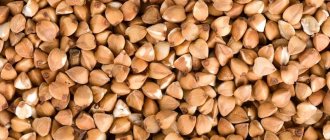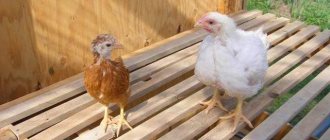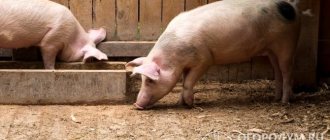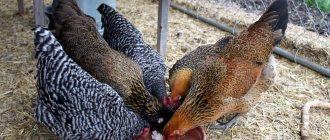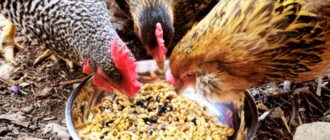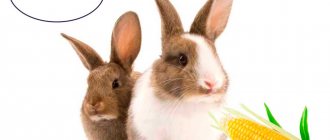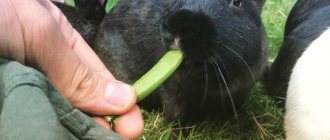1 897
no comments yet
1
Author:
Rasskazov Pavel.
Reading time: 2 minutes
Zucchini is a natural product that consists of 93% water. In addition, this vegetable contains fiber, which has an irritating effect on the gastrointestinal tract of birds.
As a result of this effect, the secretory function of the intestine is enhanced, and fiber is formed, which is necessary for the removal of bile and the reduction of cholesterol. As a result, chickens and adult birds do not suffer from obesity.
Features of feeding chickens with zucchini
What kind of feed laying hens eat affects their health. Some foods can cause digestive upsets and wash away beneficial substances from the body. Poultry needs vegetables. The best ones include pumpkins, zucchini, carrots, cabbage, and beets. Chickens eat them with pleasure.
Experienced farmers recommend feeding laying hens and broiler chickens zucchini, chopping it using a grater or an electric meat grinder. The vegetable is good for chickens - it improves their productivity. In addition, the laid eggs are tasty and large in size.
Zucchini can be given to broilers, but it is worth considering that this vegetable in its raw form prevents obesity. After cooking, fewer microelements and vitamins remain in the vegetable, but starch is formed, which contributes to the deposition of fat in broilers.
What is mash
Mash is considered to be a wet type of food. This is a mixture consisting of boiled, steamed or simply moistened components. Thanks to the mixing of several components of different origins, the product turns out to be more nutritious and rich in essential nutrients, as well as vitamins and mineral elements, than, for example, grains or vegetables in their pure form. This is why wet chicken mash is considered the preferred “dish” in the poultry diet.
Raw
Feed for adult laying hens should be balanced. It is recommended to include not only grains, but also vegetables in the diet. Zucchini is considered a storehouse of nutrients. In addition, they can be stored for a long time. They are collected in the fall and stored in a cool, dry place.
If necessary, raw zucchini is chopped, but the peel is not removed. It is not recommended to replace full feeding with zucchini. This is an addition to green food, which is given after mixing with chopped grass.
With frequent use of this valuable product, chicken does not change its taste. However, poultry meat becomes more tender, and the egg production of laying hens increases.
Is it possible to give zucchini to broiler chickens? You can start introducing this vegetable into the diet of small chickens 3 weeks after hatching. Otherwise, the chickens will develop indigestion, which can lead to their death.
Main feed components
For optimal growth and weight gain, you need nutrients. This is what the fattening program and a balanced diet provide:
- Plant and animal proteins. These substances are present in grains, legumes, meat and bone meal, and are part of dairy products and meat scraps.
- Carbohydrates. The main source of the energy component of food is grains, vegetables, root vegetables, and herbs. Fiber is very important in feed, it improves digestion.
- Fats. Any food for rapid growth of broilers is enriched with fats. They will be obtained from the cakes of oilseed plants. The quantity is strictly regulated; an excess leads to obesity in chickens.
- Vitamins. The main vitamins for chickens are A, B, C, E, D. They are included in fresh greens, present in feed yeast, root vegetables, carrots, and fish oil.
- Minerals. This component ensures muscle and skeletal growth and normalizes metabolism. Minerals are found in bone and fish meal, grain, and various additives (chalk, shells).
The nutrition of broilers and the daily need for healthy ingredients differ at different periods of life, so feeding must be properly balanced by day and month. For example, small chickens need more protein. During intensive fattening, emphasis is placed on carbohydrates, and at the end, fats are reduced in the diet.
In mash
The ideal option for feeding laying hens at home is mash. You can add almost any vegetables to them, and zucchini is no exception. Most often they are added to the summer mash, but if the vegetables have been preserved by frost, you can add them to the winter one. To prepare it you will need:
- 50 g potatoes;
- 50 g of carrot or beet tops, clover, green onions, dandelions or nettles;
- 50 g of carrots and zucchini;
- 45 g grain;
- 20 g meal;
- 4 g beans;
- 7 g yeast;
- 10 g sour milk;
- 5 g meat and bone meal;
- 3 g chalk;
- 1 g fish oil;
- 0.5 g salt.
The proportions are indicated for 1 hen. Root vegetables must be boiled and chopped. Bran, beans, and yogurt are added to the mass. The mixture is thoroughly mixed. Otherwise, the grain will not be soaked well. The greens are chopped and added to the mixture. After mixing, the mash is laid out in feeders. Premixes can be added to the winter version of this food.
Compound
Usually it includes whole or crushed grains of various crops and root vegetables. Greens are also added: cut grass, tops of garden vegetables, onions, dill and nettles, legumes, Jerusalem artichoke and more. They also include bran, boiled fish, meat scraps, kitchen scraps, etc.
In the mash, especially for laying hens, you need to add industrial premixes, bone or fish meal, chalk, crushed shells and salt, and yeast. It can be mixed with water or whey, yogurt, skim milk, skim milk or broth (for 1 kg of dry ingredients you need to take 0.2-0.5 liters of liquid, but not more than 40% of the total amount of feed).
In summer you can use cool water, in winter the liquid must be heated so that the chickens eat warm food. The consistency of the mixture should be loose and crumbly: you can check its density by squeezing a little of the mash in your hand. If cooked correctly, it should crumble and not clump together. If the mixture is pasty, it can harm the chickens, causing blockage of the nasal passages and inflammation of the mucous membranes.
You need to prepare the mash immediately before feeding and only once, so that the bird eats it all in 40-50 minutes. If the chickens manage to eat it earlier, then the rate of feed distribution must be increased; if, after time has passed, there is still food left in the feeder, then the amount of feed distributed must be reduced.
It is better to give wet food in the morning, and dry grain in the evening. You only need to pour 1/3 of its volume into the feeder so that the chickens cannot throw food out of it onto the floor. You cannot leave anything in the feeder, as wet food quickly turns sour and spoils, and a bird that eats it may experience digestive upset.
The benefits of this vegetable
Zucchini is approximately 93% water. They do not contain trans fats and are considered dietary products. The calorie content of 100 grams of product is 24 kcal. Can be given raw or after heat treatment. In the first case, the chickens get more benefits. The vegetable contains fiber, which irritates the poultry's gastrointestinal tract receptors. As a result, the secretory function of the intestine is enhanced. Fiber promotes the formation and excretion of bile acids containing cholesterol. This saves laying hens from obesity.
